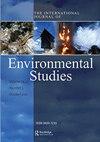Investigating the environmental Kuznets curve hypothesis for CO 2 emissions in Nordic countries
International Journal of Environmental Studies
Pub Date : 2023-10-04
DOI:10.1080/00207233.2023.2263250
引用次数: 0
Abstract
ABSTRACTThis paper examines the environmental Kuznets curve (EKC) hypothesis in Nordic countries (Denmark, Finland, Iceland, Norway and Sweden) over the period 1981–2018. The link between economic growth and carbon dioxide (CO2) emissions is analysed. The study includes causality analysis and controls for cross-sectional dependence (CSD), slope heterogeneity, stationarity and cointegration patterns. Estimations validate the EKC hypothesis for Denmark and Iceland, but not for Norway and Sweden. Finland data show no significantly visible trend.KEYWORDS: CO2EKCCSDheterogeneitycausalityNordic Disclosure statementNo potential conflict of interest was reported by the author(s).Notes1. The Nordic countries have been included in the developed, OECD, Arctic and ‘highly innovative’ country-clusters in previous studies, however.2. Carbon dioxide, nitrous oxide, methane, sulphur hexafluoride, fluorinated gases are some of the GHGs.3. The studies of Dogan et al. [Citation3], Koçak and Ulucak [Citation70], Destek and Sarkodie [Citation45], Allard et al. [Citation9] were also followed to build the econometric model.4. These models generally represent an IPAT approach, (i.e., Influence = Population, Affluence, and Technology) originally introduced by Ehrlich and Holdren [Citation71] but later reformulated by Rosa and Dietz [Citation49].5. Many studies have also included a cubic term of Y (i.e., Y3) to check whether the EKC curve is N-shaped.6. Balsalobre-Lorente and Álvarez-Herranz [Citation72] and Allard et al. [Citation9] suggest that the EKC will adopt different shapes as follows: (i) β1 = β2 = 0 ⇒ Either no link between environmental degradation and income or a flat pattern, (ii) β1 >0 and β2 = 0 ⇒ Environmental degradation increases with income monotonically, (iii) β1 <0 and β2 = 0 ⇒ Environmental degradation increases with income monotonically, (iv) β1 >0 and β2 <0 ⇒ The classical inverted U-shaped EKC, and (v) β1 <0 and β2 >0 ⇒ A U-shaped relation between environmental degradation and income.7. StataMP 18 and various user-written routines of this programme were used for the empirical analysis. All of these results are reproducible. Data and software commands are available upon request.8. The feedback hypothesis suggests that if sustainable management options are adopted in the production and consumption of natural resources, the rate of natural resource depletion and environmental stress declines.研究北欧国家二氧化碳排放的环境库兹涅茨曲线假设
摘要本文对1981-2018年北欧国家(丹麦、芬兰、冰岛、挪威和瑞典)的环境库兹涅茨曲线(EKC)假设进行了检验。分析了经济增长与二氧化碳排放之间的联系。该研究包括因果分析和控制横截面依赖性(CSD),斜率异质性,平稳性和协整模式。估计证实了丹麦和冰岛的EKC假设,但挪威和瑞典没有。芬兰的数据没有显示出明显的趋势。关键词:co2ekccs异质性因果关系北欧披露声明作者未报告潜在的利益冲突。然而,在以前的研究中,北欧国家已被列入发达、经合发组织、北极和“高度创新”的国家群。2 .二氧化碳、一氧化二氮、甲烷、六氟化硫、氟化气体是一些温室气体。参照Dogan等[Citation3]、koak和Ulucak [Citation70]、Destek和sarkozy die [Citation45]、Allard等[Citation9]的研究构建计量经济模型。这些模型通常代表了一种IPAT方法(即,影响=人口,富裕和技术),最初由Ehrlich和Holdren提出[Citation71],但后来由Rosa和Dietz重新制定[Citation49]。许多研究还加入了Y的三次项(即Y3)来检验EKC曲线是否为n形。Balsalobre-Lorente和Álvarez-Herranz [Citation72]和Allard等人[Citation9]认为EKC将采用以下不同的形状:(i) β1 = β2 = 0⇒环境退化与收入之间要么没有联系,要么呈平坦模式;(ii) β1 >0和β2 = 0⇒环境退化随收入单调增加;(iii) β 10和β 20⇒环境退化与收入之间呈u型关系。使用StataMP 18和该程序的各种用户编写例程进行实证分析。所有这些结果都是可重复的。数据和软件命令可应要求提供。反馈假说认为,如果在自然资源的生产和消费中采用可持续的管理办法,自然资源枯竭和环境压力的速度就会下降。
本文章由计算机程序翻译,如有差异,请以英文原文为准。
求助全文
约1分钟内获得全文
求助全文
来源期刊

International Journal of Environmental Studies
Social Sciences-Geography, Planning and Development
CiteScore
3.30
自引率
0.00%
发文量
121
期刊介绍:
For more than 45 years, the International Journal of Environmental Studies has been pre-eminent in its field. The environment is understood to comprise the natural and the man-made, and their interactions; including such matters as pollution, health effects, analytical methods, political approaches, social impacts etc. Papers favouring an interdisciplinary approach are preferred, because the evidence of more than 45 years appears to be that many intellectual tools and many causes and effects are at issue in any environmental problem - and its solution. This does not mean that a single focus or a narrow view is unwelcome; provided always that the evidence is indicated and the method is robust. Pragmatic decision-making and applicable policies are subjects of interest, together with the problems in establishing facts about dynamic systems where long periods of observation and precise measurement may be difficult to secure. In other words, a systems or holistic approach to the environment and a scientific analysis are complementary, and the distinction between ’hard’ and ’soft’ science is bridged in most of the papers published. These may be on any item in the agenda of environmental science: land, water, food, conservation, population, risk analysis, energy, economics of ecological and non-ecological approaches, social advocacy of arguments for change, legal measures, implications of urbanism, energy choices, waste disposal, recycling, transport systems and other issues of mass society. There is concern also for marginal areas, under-developed societies, minorities, species loss; and indeed no element of the subject of environmental studies, seen in an international and interactive mode, is excluded.
 求助内容:
求助内容: 应助结果提醒方式:
应助结果提醒方式:


